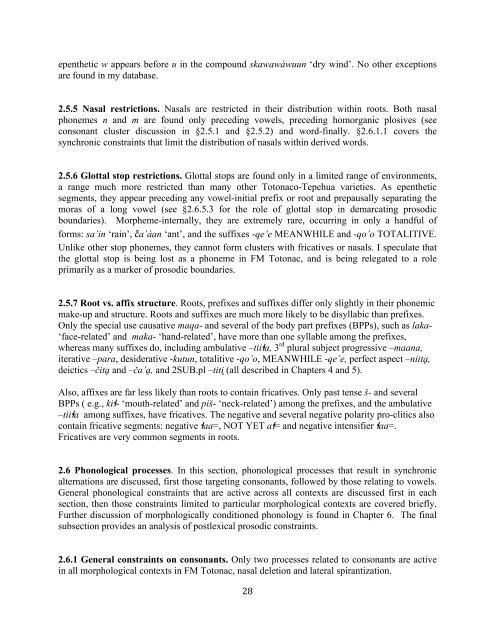The phonology and morphology of Filomeno Mata Totonac
The phonology and morphology of Filomeno Mata Totonac
The phonology and morphology of Filomeno Mata Totonac
Create successful ePaper yourself
Turn your PDF publications into a flip-book with our unique Google optimized e-Paper software.
epenthetic w appears before u in the compound skawawáwuun ‘dry wind’. No other exceptions<br />
are found in my database.<br />
2.5.5 Nasal restrictions. Nasals are restricted in their distribution within roots. Both nasal<br />
phonemes n <strong>and</strong> m are found only preceding vowels, preceding homorganic plosives (see<br />
consonant cluster discussion in §2.5.1 <strong>and</strong> §2.5.2) <strong>and</strong> word-finally. §2.6.1.1 covers the<br />
synchronic constraints that limit the distribution <strong>of</strong> nasals within derived words.<br />
2.5.6 Glottal stop restrictions. Glottal stops are found only in a limited range <strong>of</strong> environments,<br />
a range much more restricted than many other <strong>Totonac</strong>o-Tepehua varieties. As epenthetic<br />
segments, they appear preceding any vowel-initial prefix or root <strong>and</strong> prepausally separating the<br />
moras <strong>of</strong> a long vowel (see §2.6.5.3 for the role <strong>of</strong> glottal stop in demarcating prosodic<br />
boundaries). Morpheme-internally, they are extremely rare, occurring in only a h<strong>and</strong>ful <strong>of</strong><br />
forms: sa’in ‘rain’, c%a’áan ‘ant’, <strong>and</strong> the suffixes -qe’e MEANWHILE <strong>and</strong> -qo’o TOTALITIVE.<br />
Unlike other stop phonemes, they cannot form clusters with fricatives or nasals. I speculate that<br />
the glottal stop is being lost as a phoneme in FM <strong>Totonac</strong>, <strong>and</strong> is being relegated to a role<br />
primarily as a marker <strong>of</strong> prosodic boundaries.<br />
2.5.7 Root vs. affix structure. Roots, prefixes <strong>and</strong> suffixes differ only slightly in their phonemic<br />
make-up <strong>and</strong> structure. Roots <strong>and</strong> suffixes are much more likely to be disyllabic than prefixes.<br />
Only the special use causative maqa- <strong>and</strong> several <strong>of</strong> the body part prefixes (BPPs), such as laka-<br />
‘face-related’ <strong>and</strong> maka- ‘h<strong>and</strong>-related’, have more than one syllable among the prefixes,<br />
whereas many suffixes do, including ambulative –tii!a, 3 rd plural subject progressive –maana,<br />
iterative –para, desiderative -kutun, totalitive -qo’o, MEANWHILE -qe’e, perfect aspect –niit!,<br />
deictics –$it! <strong>and</strong> –$a’!, <strong>and</strong> 2SUB.pl –titi" (all described in Chapters 4 <strong>and</strong> 5).<br />
Also, affixes are far less likely than roots to contain fricatives. Only past tense #- <strong>and</strong> several<br />
BPPs ( e.g., ki!- ‘mouth-related’ <strong>and</strong> pi#- ‘neck-related’) among the prefixes, <strong>and</strong> the ambulative<br />
–tii!a among suffixes, have fricatives. <strong>The</strong> negative <strong>and</strong> several negative polarity pro-clitics also<br />
contain fricative segments: negative !aa=, NOT YET a!= <strong>and</strong> negative intensifier !aa=.<br />
Fricatives are very common segments in roots.<br />
2.6 Phonological processes. In this section, phonological processes that result in synchronic<br />
alternations are discussed, first those targeting consonants, followed by those relating to vowels.<br />
General phonological constraints that are active across all contexts are discussed first in each<br />
section, then those constraints limited to particular morphological contexts are covered briefly.<br />
Further discussion <strong>of</strong> morphologically conditioned <strong>phonology</strong> is found in Chapter 6. <strong>The</strong> final<br />
subsection provides an analysis <strong>of</strong> postlexical prosodic constraints.<br />
2.6.1 General constraints on consonants. Only two processes related to consonants are active<br />
in all morphological contexts in FM <strong>Totonac</strong>, nasal deletion <strong>and</strong> lateral spirantization.<br />
! #,!

















